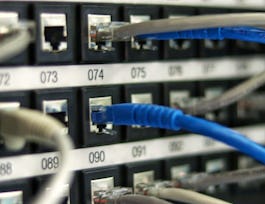Jumpstart your career in Information Technology (IT) with this beginner friendly, self-paced course! By taking this course you will enhance your base knowledge of essential skills in networking, storage, and system administration.



Introduction to Networking and Storage
This course is part of multiple programs.

Instructor: IBM Skills Network Team
Sponsored by PTT Global Chemical
31,153 already enrolled
(475 reviews)
Recommended experience
What you'll learn
Identify wired and wireless network types, explain physical and logical topology, differentiate network cable types and what each is used for.
List common network devices. Discover what packets are and how IP addresses work, and explain what protocols are and why models are necessary.
Determine how to set up and encrypt networks and mobile devices. Diagnose connectivity issues and utilize the command prompt and Windows Settings.
List network drive types, explain RAM, ROM, and RAID, and troubleshoot storage issues. Explain STaaS, and define file, block, and object storage.
Skills you'll gain
Details to know

Add to your LinkedIn profile
9 assignments
See how employees at top companies are mastering in-demand skills

Build your subject-matter expertise
- Learn new concepts from industry experts
- Gain a foundational understanding of a subject or tool
- Develop job-relevant skills with hands-on projects
- Earn a shareable career certificate


Earn a career certificate
Add this credential to your LinkedIn profile, resume, or CV
Share it on social media and in your performance review

There are 5 modules in this course
Computer networking plays a vital role in facilitating the communication required in almost every aspect of daily life. Activities like talking with friends and family, collaborating with coworkers, paying bills, and even completing transactions at a store often depend on some form of computer networking. Computer networking is defined as the connection of people through the use of devices and cables, and sometimes wireless signals. This week, you will learn about the basic types and shapes of networks and how they are used. You will also learn about wired connections, wireless connections, and network cables. And finally, you will learn about the advantages and disadvantages of each network type.
What's included
6 videos1 reading2 assignments2 plugins
Understanding the foundations of how all networks behave is achieved by investigating the rules. That includes finding out how each rule works and observing how each rule is applied to the network and how the network is affected by that rule. This week, you will learn about networking devices and the basic instructions they follow to connect us in the ways we expect. You will understand how data is packaged electronically, which rules are used to send the data, how those rules are made, and how computers determine where to send those data packages.
What's included
6 videos1 reading2 assignments3 app items1 plugin
One of the key components of communicating is understanding how to communicate. That includes knowing what enables communication, and what blocks it. This is just as true for computer networking as it is for person-to-person interactions. If you don’t understand the ways to get data from one point to another, the data will never arrive where you want it to. This week you will learn the basic steps for setting up small office or home office networks—including wired, wireless, and mobile configurations. You’ll explore Network Settings in Windows and then learn what causes network connectivity problems and how to resolve those problems. Finally, you will learn how command line utilities can be used to find network information and diagnose network issues.
What's included
6 videos1 reading2 assignments3 app items2 plugins
As we’ve discussed, connection plays a vital role in communication. Another key component in communication is memory; information is not useful if it can’t be recalled. Network storage is where the memory is located in computer networking. This week you will learn about different types of network storage and basic storage troubleshooting. You’ll learn about short-term and long-term memory, and the different ways that memory can be arranged to increase capacity and efficiency. You’ll also learn about local, offsite, and cloud memory and how all these different kinds of memory enable faster and more efficient interaction between people, devices, and software.
What's included
6 videos1 reading2 assignments1 app item2 plugins
What's included
2 videos2 readings1 assignment1 peer review1 discussion prompt4 plugins
Instructor

Offered by
Why people choose Coursera for their career




Learner reviews
475 reviews
- 5 stars
80.66%
- 4 stars
14.55%
- 3 stars
3.11%
- 2 stars
0.83%
- 1 star
0.83%
Showing 3 of 475
Reviewed on Oct 4, 2023
This course help me to understand the basics of networking. Got a lot to learn
Reviewed on Jan 9, 2024
It will help you to learn Networking and Storage Devices
Reviewed on Mar 22, 2023
Perfect way to study basics on Networking and Storage on Computer
Recommended if you're interested in Information Technology

LearnQuest

University of Colorado Boulder

University of London

University of Colorado Boulder

Open new doors with Coursera Plus
Unlimited access to 10,000+ world-class courses, hands-on projects, and job-ready certificate programs - all included in your subscription
Advance your career with an online degree
Earn a degree from world-class universities - 100% online
Join over 3,400 global companies that choose Coursera for Business
Upskill your employees to excel in the digital economy


